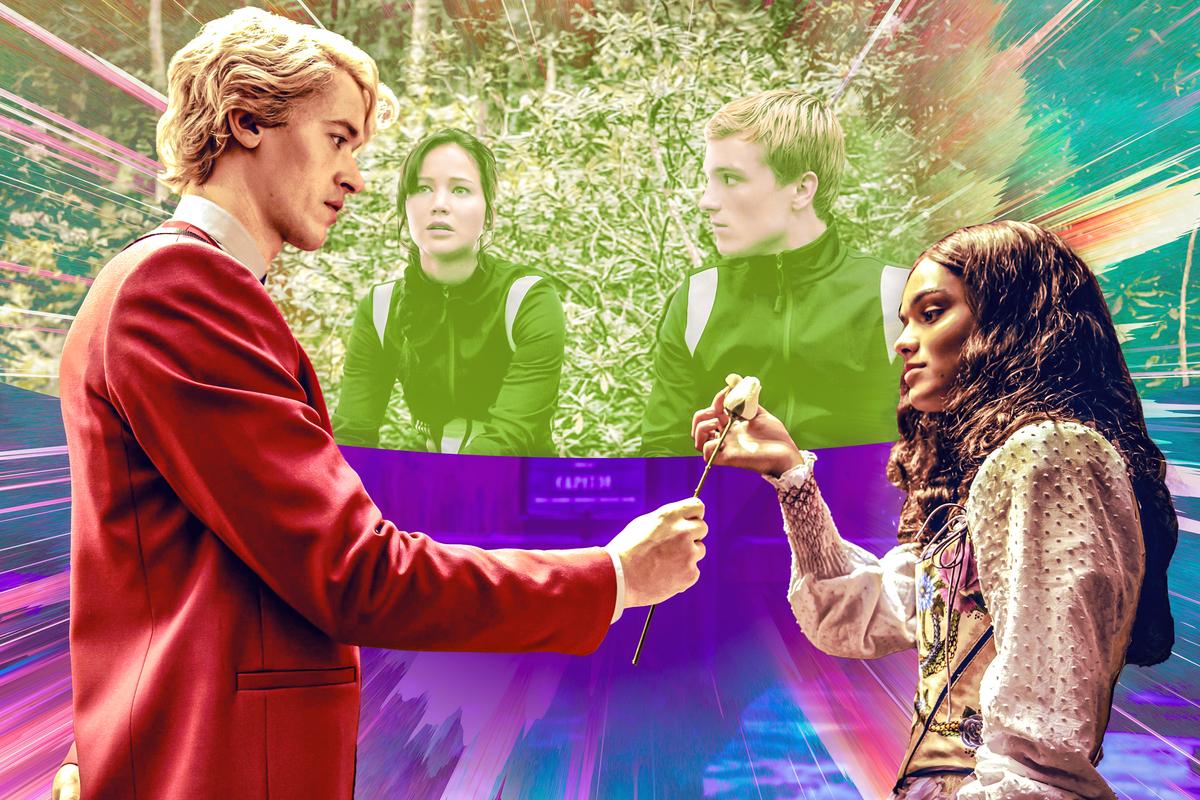
Telling a villain origin story as a prequel to a popular series is a tricky task. One need only remember the most famous example of the genre—the Star Wars prequels, with Anakin Skywalker—to see the dual potential and peril of that sort of storytelling.
Such is the opportunity and burden of The Hunger Games: The Ballad of Songbirds & Snakes, the newest entry in the billion-dollar film franchise, which will be released in theaters Thursday night. The original Hunger Games series, which consisted of three books and four movies, was a true multimedia phenomenon and sparked both Jennifer Lawrence’s A-list stardom and a young adult dystopia craze.
Based on the 2020 book by Hunger Games author Suzanne Collins, this prequel offers something genuinely different from the originals. It focuses not on a contestant in the eponymous Hunger Games or a rebel fighting the Capitol’s autocracy, but rather on an 18-year-old version of President Coriolanus Snow—Coryo for short, in his youth—and the start of his rise to power.
Ballad is mostly successful in this effort; it is a worthy addition to the franchise and features numerous world-building details and character beats that are sure to delight fans of the originals (or more recent converts attracted by this year’s apparent Netflix-fueled Hunger Games renaissance). But the very nature of this audacious experiment also means that the adaptation falls flat in some places and thus doesn’t reach the heights of either its source material or its cinematic predecessors.
Hunger Games viewers will recognize the setting and overall premise of the prequel: In a fictional future dystopia, the tyrannical Capitol forces children to kill one another for sport in a televised fight to the death to remind the country’s districts of their failed rebellion. But Ballad takes place 64 years before the inaugural story, so much of the Hunger Games’ spectacle has not yet been developed.
Katniss Everdeen and Peeta Mellark competed in the 74th annual Hunger Games, which were an institution of murder, yes, but also of pomp and pageantry. Lots of YA dystopian fiction centers on a rebellion; the Hunger Games franchise was so successful, in part, because it added a secondary element of critiquing reality TV culture and mass entertainment.
Conversely, the 10th Games, as depicted in Ballad, are a more bare-bones affair still finding their footing as spectator entertainment. Instead of conducting parades, designing elaborate costumes, and customizing big, imaginative arenas each year, the game makers in Ballad just bring 24 teens to a stadium and watch them spend a day hacking one another to bits.
Young Coryo (Tom Blyth) is ready to help the Games evolve into their fully eventized form—as they must in order to survive. As one character says early in the movie, “If the Games are to continue at all, people need to watch.” (One wonders how Lionsgate feels about this sentiment, with Ballad tracking to earn about $50 million at the domestic box office this opening weekend; all the original movies took in at least double that amount.)
Snow starts the story as a student in search of a prestigious college scholarship; to land it, he must impress the Games’ organizers with his innovative ideas, as well as successfully mentor the female contestant from District 12, Katniss’s future home. That contestant is the other key character in this story: Lucy Gray Baird (Rachel Zegler), a sort of manic pixie dream girl who captures Snow’s heart with the ballads that give the story its title.
While it revolves around the Games, just as Katniss’s saga did, Ballad focuses on Snow in the mentor role much more than Lucy Gray in the arena. Whenever she acts inside the Games, the camera pans to Coryo, watching on a screen; the audience sees her strategies through his eyes, rather than her own.
Even the narrative voice is different: The original trilogy of books was told entirely from Katniss’s first-person point of view, while the prequel uses close third-person narration, with Snow as the central perspective. This choice creates slightly more distance between the reader and the protagonist—and allows for a richer ironic interpretation as Coryo offers internal justifications for his descent into villainy.
Just as in the original Hunger Games films, the adults portraying secondary characters shine. With a pair of crimson gloves that make it look as if she’s always covered in blood, Viola Davis is appropriately unsettling as Dr. Volumnia Gaul, the mad scientist who serves as head game maker. And Jason Schwartzman steals every scene he’s in, adding much-needed levity amid the carnage as weatherman, amateur magician, and TV host Lucky Flickerman, the ancestor of Stanley Tucci’s Caesar from the original series. (Between Asteroid City, Spider-Man: Across the Spider-Verse, and now Ballad, 2023 has been quite the year for Schwartzman at the movies.)
The latter is a vital role, and a point of differentiation between Ballad and its predecessors. The original movies were made of serious stuff, to be sure—after all, they tell a story about the murder of dozens of children—but they were also brightened by numerous sources of humor, from Caesar to mentor Haymitch Abernathy (Woody Harrelson) to adviser Effie Trinket (Elizabeth Banks). Katniss is also good for the occasional sarcastic quip, which Lawrence communicates with characteristic dryness. And Donald Sutherland’s older President Snow is full of smiles that underscore his menace.
But Ballad relies on Lucky Flickerman for all its comedy; after he leaves the screen for good, there aren’t any laughs at all in the last hour of the film. Unlike the protagonist or Snow in the originals, young Coryo is painfully humorless.
That’s a crucial missing element because Ballad is a challenging watch at times and could benefit from more tonal variation. This film doesn’t shy away from brutality: It references cannibalism in the very first scene, and its cameras often linger on the child victims’ final breaths in the arena.
Another hiccup with Ballad’s text-to-screen adaptation is its ending, which feels rushed even though this is the longest Hunger Games movie to date, at a robust two hours and 37 minutes. (To be fair, the prequel book is some 150 pages longer than those in the original trilogy.)
The story is split into three parts, the last of which takes place outside the Capitol. This portion of the novel relies especially on Coryo’s interior thoughts, as he struggles to balance his crush on Lucy Gray with his deep-seated yearning for power. The final act in the book is wonderfully paranoid and surreal, with the effect of a fever dream; on the screen, without the advantages of the close third-person narration, it comes across as more cartoonishly melodramatic.
But the greatest issue exacerbated by the change in medium is the emotional disconnect inherent in a high-minded villain origin story. It’s easy to root for Lawrence’s rebellious Katniss and her romance with Josh Hutcherson’s Peeta; it’s much harder to latch on to Coryo, the burgeoning dictator, and his star-crossed fling with Lucy Gray.
“Make the stakes personal,” Coryo says during the movie, as part of an argument to humanize the contestants with on-camera interviews. “People need someone to root for.” The same idea applies to the film itself, which generally struggles to foster meaningful connections to its characters.
For instance, one of the first film’s most powerful moments came when Katniss sang a lullaby to ally Rue and spread flowers over her dead body. But the sister scene in Ballad is comparatively cold, as it involves a relatively anonymous character caring for the corpses of relatively anonymous contestants.
Zegler tries her best as Lucy Gray. To Collins’s credit, the author invented an entirely different character here: It would have been easy to create a Katniss clone, but Lucy Gray is ebullient where Katniss is sullen, emotional where Katniss is reserved. Coryo’s crush is full of songs and homespun sayings; she’s comfortable on a stage. But Lucy Gray isn’t the main character, so her charisma can go only so far.
Moreover, it makes narrative sense that the fledgling romance between Coryo and Lucy Gray wouldn’t captivate like Katniss and Peeta’s. Snow is a villain who abuses his power; his isn’t supposed to be a healthy relationship. But that justification doesn’t make for a more compelling viewing experience. At some point, the Ballad adaptation just has a Jennifer Lawrence–shaped hole in its emotional core.
Not as many readers were receptive to this new direction for the series. On Goodreads, for instance, Ballad received many fewer reviews and much worse ratings than its predecessors.
‘Hunger Games’ Series Goodreads Ratings
As a reader, I disagreed with that consensus on the prequel; even if I couldn’t connect as well to the characters, I appreciated the craft of the novel a great deal. I also found it particularly refreshing that Collins told a new story rather than cash in with a rote expansion of her fictional universe and milk the IP for all it’s worth. She didn’t release the Ballad novel until 2020, a full decade after Mockingjay concluded the Katniss trilogy; she wouldn’t have written another entry if she didn’t feel she had something new to say.
With this effort, both the book and movie versions generally avoid the worst traps to which prequels most often succumb. Because it takes place so many decades in the past, the fates of many of its characters (alas, not Snow) are mysteries to viewers. Its cameos are minimal, its Easter eggs mostly unobtrusive. (There is, however, one “Katniss” reference that will make you either light up or groan deeply, depending on your tolerance for such things.)
But ultimately, this villain origin story works better as an intellectual exercise in book form than an immersive cinematic experience. Ballad offers Hunger Games fans a new flavor, and it tastes pretty good—just not quite as fresh as the original.


